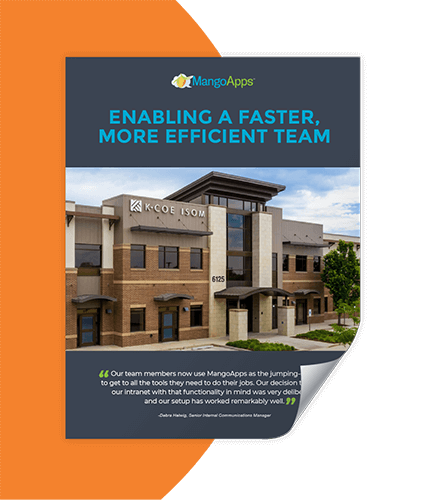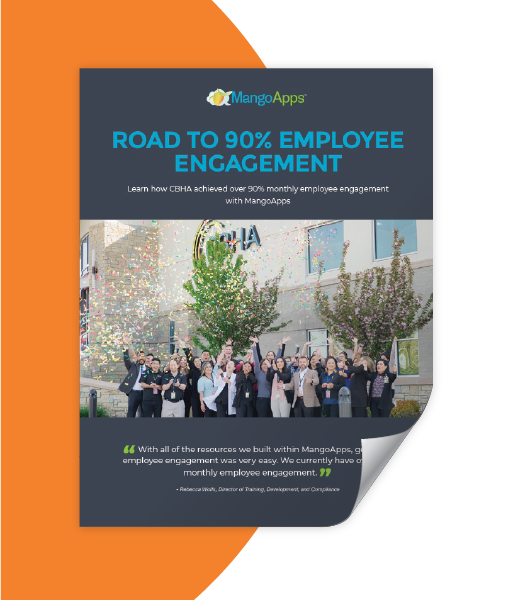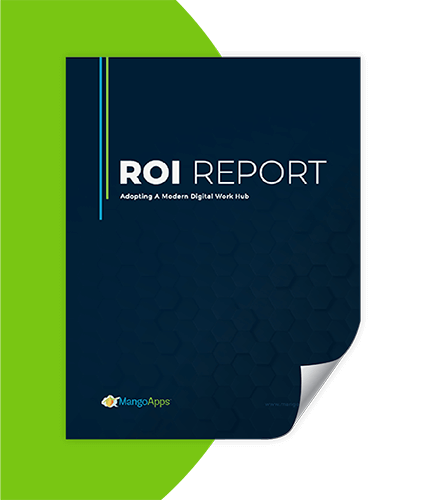Too many companies rely on email for all of their internal collaboration. By having email as the primary source of communication, it can result in a cascade of productivity issues.
Employees receive so many emails that it becomes very difficult to create a sense of priority. Thus, they start to tune out certain messages and may end up missing out on key information.
In fact, the average full-time employee spends approximately 2.6 hours navigating and responding to emails every day. This is a massive time-suck and leads to wide-spread decreased productivity across your workforce.

In this article, we’ll discuss why you should replace email. We’ll also touch on how an internal collaboration tool can help improve collaboration and efficiency within your organization.
Jump to a topic:
- 5 Reasons email is limited for your organization
- Why collaboration tools will replace email
- How to reduce email overload
- Why email hinders productivity
- Replace email with MangoApps
5 Reasons Email Is Limited For Your Organization
#1: Email licenses are expensive
With the average email license costing a minimum of $4 per user, the associated cost of providing every employee with an email account can be an extremely significant cost to your organization.
To learn more about why employees don’t need email addresses, visit this blog here.
#2: Email hinders productivity
Not only does providing employees with email accounts represent a significant cost on the licensing front, but it can also be detrimental to employee productivity as well.
Every time your employee receives an email, it serves as an interruption from accomplishing the task at hand. More often than not, the email is irrelevant to the employee’s job and serves only as a distraction from their main work priorities.
Use Case – IT Department
For large organizations, employee turnover is a part of business. Requiring your already busy IT department to create and cancel individual email accounts every time a termination or new hire occurs represents a massive time suck.
Effectively managing emails is a lot of busy work that can deter IT from working on more impactful projects.
#3: Email doesn’t meet the needs of frontline employees
The cost of email adds up if you are spending money on email licenses for your frontline workforce. While providing an email account to your desk employees might make sense, it’s not effective for communicating with frontline teams.
Corporate pushes out mass email notifications, which frontline workers will largely ignore, as it is often irrelevant to their jobs. To make matters even worse, when a particular frontline employee needs to access a file or resource, they then have to dig through a crowded email inbox of irrelevant messages to find it.

For an organization with 2,000 frontline employees, replacing email with an internal collaboration platform can save you up to $96,000 in licensing fees a year.
To learn more about the ROI your organization can receive from replacing email, visit this blog here.
#4: Collaboration is inefficient
With email, it is incredibly difficult to keep track of which file version is the most recent. As separate conversations and email threads occur, making sure you have access to the latest version of a file is seemingly impossible.
Another major drawback of email is that you only receive information from the conversations that you are included in.
If knowledge is shared in a separate email conversation, you won’t be privy to it. With email, it can be difficult to keep everyone in the loop, especially for larger teams.
Email also doesn’t offer a way for employees to react or acknowledge that they have seen a message. This can lead to mass confusion and uncertainty as to whether colleagues have received the information they need. Employees would have to respond to the email to verify that they have seen it.
#5: Email isn’t searchable
Arguably one of the biggest liabilities of email is that it doesn’t offer a searchable repository of information. Conversations and email threads are siloed and as a result, searching for information, resources, and conversations can be a massive waste of time.
Use Case – KCoe Isom
Debra Helwig, a Senior Internal Comms Manager at KCoe Isom, had this to say about why they decided to replace email: “Firmwide email isn’t searchable. If I don’t read something, or don’t see it, or let it get a hundred down in my inbox, or hit the delete button by accident, there’s no institutional memory.”

How K·Coe Isom Saves $50,000 Annually With MangoApps
Learn how K·Coe Isom replaced their old intranet and knowledge management platform with MangoApps, resulting in annual savings of $50,000.
Why Collaboration Tools Will Replace Email
Email usage has grown to the point that inboxes fill faster than can be handled. Between emails that are irrelevant to your job and being looped into conversations that don’t pertain to you, inboxes are quickly filling up with junk.
Navigating this constant sea of emails to find important information can be exhausting and seriously diminish an employee’s productivity. Not to mention, it can negatively impact an employee’s engagement level.
The problem with email
The main issue with email, is that it is used for everything within a company. Employees have to navigate a single inbox that is spammed with information requests, status reports, task assignments, communications, meeting invites, notices from HR, and everything in between.
Email inboxes are flooded with messages, but only a fraction of those emails actually deserves an employee’s immediate attention.
A typical employee will prioritize emails that are sent by a sender or subject of interest, and the rest of the emails are saved for them to inevitably not be seen.
As we apply this method of deferring reading email, we let the count of unread emails grow at the risk of missing important information.
The solution: Internal collaboration tools
With an internal collaboration tool, employees are no longer spammed with irrelevant messages. They only receive information that is relevant to them and their job specifically.
Colleagues can communicate and collaborate on important projects and not have to worry about being left out of the loop.
Employees can be equipped with the tools they need to collaborate and stay in the loop on important projects without having to receive messages that don’t pertain to them.
This new social-media style of workplace collaboration is aimed at improving efficiency and making sure that information is personalized and targeted.

How YMCA Leveraged Analytics
Learn how the YMCA used MangoApps’ analytics & insights to improve the communications they send out and further boost engagement of distributed content.
How To Reduce Email Overload
Here are the top 5 ways companies can reduce email overload and encourage successful communication:
#1: Collaboration tools
Having an integrated collaboration tool is a great way to reduce email overload. This ensures that key emails are tracked, and employees are notified about updates.
This is especially important when employees use a single email for both personal and office use. Collaboration tools can even replace emails by creating a centralized location for communication and company information.
Additionally, collaboration tools can sync with an employee’s calendar and send automatic reminders about upcoming events. This encourages organization and communication, while benefiting the company and its employees.
#2: Organization and filters
Email marketing has a median ROI of over 122%. While that might be good news for businesses in general, for an employee, it often means an inbox flooded with promotional messages.
If an employee wants to sort important emails from junk, it’s vital for them to set inbox labels and filters. How an employee organizes their own inbox often comes down to personal preference.
An inbox, for example, could show company emails first or have enabled notifications for priority messages. Whatever you choose, some kind of system needs to be in place.
Organizing your inbox can make the difference between keeping up with important announcements and having to declare email bankruptcy.
#3: Light and lean inboxes
Employees should avoid subscribing to promotional material, newsletters and other non-work-related subscriptions from their office email. Enough extra promotional material will end up in your inbox without you asking for it.
Spending some time now to unsubscribe from promotional emails will save you from hundreds of future unwanted emails. It will also make it much easier to keep a clutter-free inbox.
Sometimes it is even necessary to block a sender so that they become more responsible in the future.
Work-related emails that are no longer active need to be archived and moved out of the inbox. Lastly, any ongoing email threads should always be as succinct and clear as possible.

How CBHA Improved Collaboration With MangoApps
Learn how Columbia Basin Health Association used MangoApps to improve social interactions and foster increased collaboration across dispersed teams.
Why Email Hinders Productivity
As the struggle to keep on top of company emails seems to grow daily, employees are doing whatever it takes to reach an empty inbox. They’ll try time management solutions and efficiency shortcuts to try and chip away at the mountain of emails they receive in a way that doesn’t diminish productivity.
Unfortunately, these shortcuts are ineffective and don’t get to the real root of the problem.
The problem with email is that it pushes out information to users. Regardless of the user’s interest in the content or how little it pertains to their job role, they are forced to engage with it.
In doing this, your employees must make dozens of micro-decisions daily when they receive an email notification or open their inbox. Doing this over and over can be exhausting and lead to reduced productivity. Not to mention, email, by nature, distracts and diverts the user’s attention from the task at hand.
If email is so distracting and hinders employee productivity, then how are organizations supposed to communicate effectively?
Fortunately, there is a better style of communication that is much less intrusive and doesn’t distract you from your work. This is known as ‘pull communication’.
Empower employees with an internal collaboration tool
Unlike push communication, which is demanding and intrusive, pull communication acts as an invitation. It gives employees control over their content and work based on specific needs.
In a ‘pull system,’ users are made aware of the content and are invited to engage with it, but can still choose for themselves when, where, and even if they interact with it.
An example of this style of communication is social media.
On social media, users decide who they want to follow, who can follow them, and what followers are allowed to see; this leads to relevant content that is specific to each individual user.
For a business use case – the solution that best mimics this type of engagement is an internal collaboration tool.
With an internal collaboration tool, users can follow or comment on various company groups, projects, or teams. Having designated areas for specific content keeps information clear and organized and makes collaboration easier.
Employees can join or leave groups as needed so that they are only in the loop on conversations that are relevant to them.
This relevant information can populate into a personalized newsfeed. Think of it as a social media platform for your work.
Imagine a dashboard with personalized content where you can see information that pertains to your job and are no longer bogged down by email blasts that are irrelevant and distracting.

Calculate the ROI of MangoApps
In this report, we take a look at how to measure the return on investment of adopting a modern digital work hub such as MangoApps.
Replace email with MangoApps
MangoApps offers an internal collaboration tool that can transform how employees within your organization communicate and collaborate.
MangoApps allows employees to send targeted and personalized messages to anyone in the organization, from any device, without the distractions or frustrations of an inbox cluttered with SPAM or irrelevant messages.
Because all of the interactions happen internally, your organization can rest assured, knowing that employees are communicating safely and securely while avoiding phishing or other malicious threats that come with email.
By bringing organization-wide internal communication into a single platform like MangoApps, your organization will realize benefits such as improved employee productivity, boosted employee engagement, and a much more collaborative workforce.







